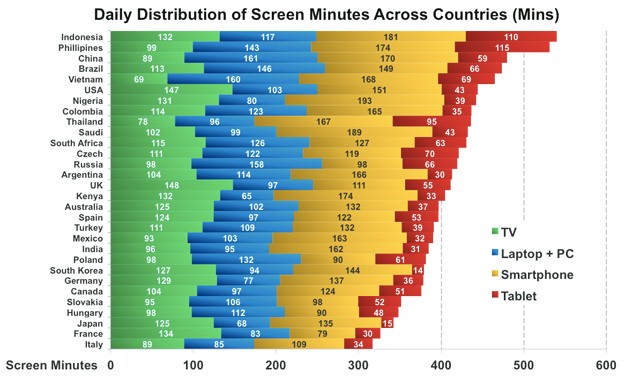TECHNOLOGY AND EYES
When we try to analyse technology and its impacts, the results are grey and not a definitive black-and-white, more often than not. With the advent of newer devices of communication, we are glued to one screen or the other, ranging from TV, laptop/PC, smartphones to tablets, for more than 6 hours a day (according to Mary Meeker’s 2014 annual presentation on Internet trends).

Image source: Quartz
Blue light is part of the visible light spectrum which has a shorter wavelength and carries a high amount of energy. Even though the sun is the biggest source of blue light, there still remains worrisome debate over the long-term effects of screen exposure because of the close proximity of the screens and the long duration of time spent looking at them. According to a recent NEI-funded study, children’s eyes absorb more blue light than adults from digital device screens. Experts also suggest that blue light causes digital eye strain, fatigue and retina damage. It also leads to sleeplessness and decreased quality and quantity of sleep. Blue light exposure may increase the risk of macular degeneration. The way that blue light infiltrates the distance to the retina (the internal coating of the back of the eye) is important since lab studies have shown that higher exposure to blue light can harm light-sensitive cells in the retina. Front structures of the grown-up human eye (the cornea and lens) are exceptionally successful at blocking UV rays from reaching the light-sensitive retina at the back of the eyeball. In fact, less than 1% of UV radiation from the sun reaches the retina, regardless of whether you are wearing shades. Unlike this, basically, all blue light goes through the cornea and lens and reaches the retina. Nowadays, a large number of us have occupations that expect us to stay glued to digital screens for a considerable length of time in a go. This can put a lot of strain on your eyes. Eye issues caused by digital screens fall under the heading computer vision syndrome (CVS). It isn’t one particular issue. Rather, it incorporates an entire array of eye strain and pain.
Now, this is where technology comes in as a saviour to combat the harmful effects of blue light on our eyes.
The following methods can be used for the same:
- Computer glasses: Computer glasses with yellow-tinted lenses that block blue light by increasing contrast can help ease digital eye strain.

Image source: Pixabay.com
- Anti-reflective lenses: Anti-reflective lenses lessen the glare, increase contrast and block blue light from the sun and digital devices as well.
- Consulting an eye specialist: Consulting an eye specialist for more specific opinion based on your situation still remains the most trusted option of all.
You don’t need to strain your eyes to look for a solution anymore. Book your appointment at the online portal of Mumbai Eye Care here